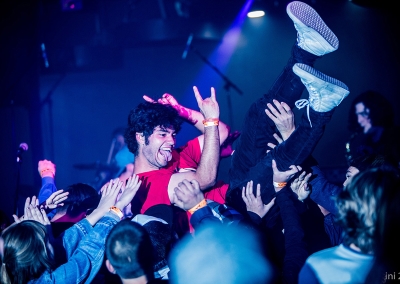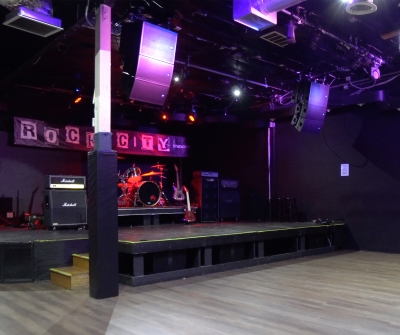
System Quest
The upgraded sound reinforcement situation will certainly help that initiative. “The old system was dated,” Brown notes. “It was loud but not clean. We really wanted tighter bass and the thump in the chest kids want these days.” Outside of a central sweet spot, there was inadequate coverage and clarity, and even providing adequate sound pressure levels required doubling up on loudspeakers, which led to comb filtering and interference.
“So we went to NAMM in 2015 to scope out PA vendors,” Brown says, “and one night Brett called me and said, ‘You’ve got to get over to the Hilton lobby and hear the system.” It was headed by Renkus-Heinz IC² digitally steerable arrays, and Brown was impressed: “I could carry on a conversation on the upper balcony yet hear fantastic sound on the floor in front of the band.”
The first point of contact in the system quest was Jeff Miranda of Pacific AV at the Renkus Heinz booth at the show. In discussions about Rock City’s needs, it became apparent to Miranda that the IC² rig was a bit more than what was necessary for the room in terms of power and capabilities. “I used to be an integrator and did a lot of system design, so I thought the CFX101LA [full-range modular arrays] would be a good fit for this particular application,” he adds.
Initially, Brown and DeCarlo were considering self-powered CFX101LAs, but Miranda suggested instead that they be configured for bi-amplification with Linea Research amplifiers. After evaluating multiple iterations of this system approach at Rock City, they ultimately settled on a main PA comprised of CFX15S per side flown above pairs of CFX101LAs, with three K-Array KMT21P subwoofers placed equidistant beneath the stage.
“We were trying to get a lot out of a small PA, and were also fighting space restrictions for the subs, so I felt that adding a pair of CFX15S, with single 15s, to the CFX101s up in the air would help with impact,” Miranda explains. “This worked wonderfully, and nicely supplements the K-Array subs under the stage.”
The loudspeakers are driven by Linea 44C10 DSP amps (each with four channels rated at 2,500 watts), configured with two CFX101s in parallel on one channel, and each KMT21P and CFX15S on their own channels, leaving one channel open. “So we have a spare channel if something does go down,” Brown says.
“While the failure rate of the Linea Research amplifiers is exceptionally low, if there ever was an issue, because of the way this system is designed, it wouldn’t take the whole amp out, just a channel,” Miranda notes. “Things could be quickly moved around and the show could keep going. That was really important, especially to Michael.”
Putting It Together
The system was installed by DeCarlo, Brown and the Rock City crew, with tuning by Miranda and Rik Kirby of Allied Professional Technologies, U.S. distributor of Linea Research products. A bit later, baffles and bass traps were deployed as acoustic treatments to help deal with some persistent flutter echo. Absorption was also applied to the stage to make it more comfortable for the musicians.

On stage, artists are provided with Yamaha BR12M wedges and a Yamaha S112 full-range loudspeaker for drummers (all driven by QSC GX7 amps), as well as Shure PSM300 personal monitoring systems. Plans are underway for an overhaul of the monitoring capability.
The Midas M32 console handles both mains and monitors. “For a club of this size, and at its price point, it’s a good investment,” Brown says, adding that he currently uses the built-in DSP of the Linea amplifiers exclusively. “It’s all ‘in the box,’ but I’m going to incorporate a DiGiGrid interface so we can also use tools from Waves, which we’ll be investing in this year as well.”
Connectivity between the studio and live room is increasingly important as well, with Rock City offering bands the option to multitrack their performances in Pro Tools. The studio includes an Avid C|24 console and a selection of Neve, API, and UA mic preamps. “We also have cameras tied into the studio so you get video,” DeCarlo adds, noting that the inclusion of live audio/video recording was his father’s idea. Additional upgrades are also being made to the practice/lesson rooms, he continues, with the provision of projection and 2-channel recording systems, controlled via iPad.
“Between San Francisco and LA, this is a stop where artists can make money,” DeCarlo states. “Some come in thinking it’s going to be lousy, but 99 percent of the time, by the end of the show, they’re saying, ‘We want to come back.’”
The upgraded gear certainly helps, but the human element is also a big part of the attraction, Brown says. “People work here, and do this, because it’s what they love.”
As for the future? “More,” DeMartini concludes. “More community outreach, more songwriting, full spectrum and group classes, more panel discussions – the ecosystem here is all about being proactive and reviving the local music scene and interest in live music.”
